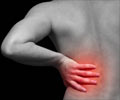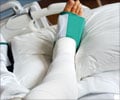- Back Strains and Sprains - (https://my.clevelandclinic.org/health/diseases/10265-back-strains-and-sprains)
- A New Episode of Low Back Pain: Who Relies on Bed Rest? - (https://psycnet.apa.org/record/2008-03023-013)
- Pulled Back Muscle and Lower Back Strain - (https://www.spine-health.com/conditions/lower-back-pain/pulled-back-muscle-and-lower-back-strain)
- Low Back Strain and Sprain - (https://www.aans.org/patients/neurosurgical-conditions-and-treatments/low-back-strain-and-sprain)
- Diagnosis and Treatment of Acute Low Back Pain. - (https://www.ncbi.nlm.nih.gov/pubmed/22335313)
- Low Back Pain Fact Sheet - (https://www.ninds.nih.gov/Disorders/Patient-Caregiver-Education/Fact-Sheets/Low-Back-Pain-Fact-Sheet)
- Taking Care of Your Back at Home - (https://medlineplus.gov/ency/article/002119.htm)
- Lumbar Back Sprains: Treatment and Prevention - (https://www.spineuniverse.com/conditions/sprains-strains/lumbar-back-sprains-treatment-prevention)
What is Back Sprain?
Back sprain is a common cause of backache and almost everyone experiences such pain at some point in life. Injuries to ligaments are referred to as sprains, while injury to tendons and / or muscles are referred to as strains.
Many times, sprains and strains occur as a result of actions such as sudden twists, turns or other vigorous movements that put extra pressure on the ligaments or muscles of the back. The ligaments in the lower back and pelvic region are important as they give stability to the spinal column. The spinal column provides most of the support to the body to stand upright as well make movements. Since the paraspinal muscles present in the back region play a major role in bearing the body weight during various movements such as running, walking, lifting, etc., they are more prone to strains.(1✔ ✔Trusted Source
Back Strains and Sprains
Go to source)
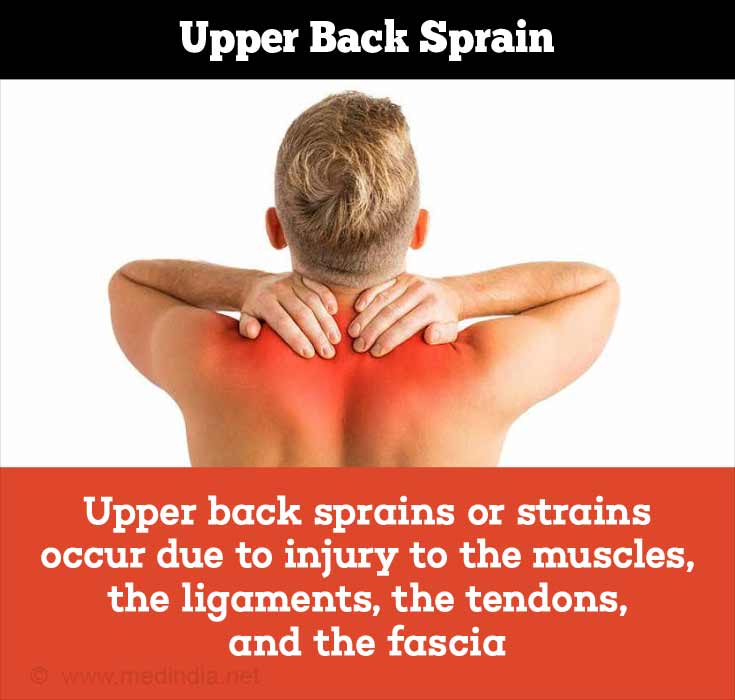
Types of Back Sprain / Strain
Lower Back Sprain / Strain
Lower back (lumbar) sprains / strains may occur as a result of everyday activities that put repetitive stress on the back region, or it may occur following an accident such as a fall or injury while playing sports. Excessive pressure on the lower back can cause stretching or tearing of the soft tissues in muscles or the ligaments. When the stretching goes beyond the normal range of movement, it leads to sprain or strain and causes severe pain.(2✔ ✔Trusted Source
A New Episode of Low Back Pain: Who Relies on Bed Rest?
Go to source)
Upper Back Sprain / Strain
Thoracic (upper back) spine is considered to be the least mobile area of the vertebral column. The upper portion of the spine and the muscles in this region are important in maintaining the upright position of the body. Upper back sprains and strains usually occur due to injury to the muscles, the ligaments, the tendons, and the fascia (fibrous tissue). The injury may occur due to accidents such as a fall, sudden twisting, or other movements that put too much force on these structures beyond their capacity. Upper back sprains or strain may also be caused due to some poor lifestyle habits such as sleeping in wrong position, taking a pillow that is too stiff or wrong sitting posture while using computer or driving.(3Pulled Back Muscle and Lower Back Strain
Go to source)
Causes of Back Sprain / Strain
Lower Back Sprain / Strain
- Sudden twisting or pulling of a muscle or tendon in the lower back e.g. during playing sports or exercise
- Overuse or prolonged use of lower back muscles e.g. carrying heavy weight everyday
- Improper lifting positions or overstressing the back muscles with heavy weight
- Repeated stress on the back muscles through improper posture, lifting, body mechanics during daily activities
- Accidents causing injury to the spine and other structures of back
- Other factors such as excessive body weight, excessively curving the lower back, having weak back or abdominal muscles may also lead to lower back strain
Upper Back Sprain / Strain
- Poor posture such as drooping of the neck and shoulders
- Repetitive motions such as lifting, twisting, and bending
- Traumatic causes including falls and accidents leading to vertebral fractures or other injuries to the spine
Symptoms of Back Sprain / Strain
Lower Back Sprain / Strain
- Severe pain in low back that feels worse with movements
- Low back pain that may radiate into buttock region
- Muscle cramping or spasms
- Stiffness in muscles of the lower back
- Tenderness and swelling at the injury site
- Loss of strength of the back muscles
- Difficulty walking, bending forward or sideways, or standing straight
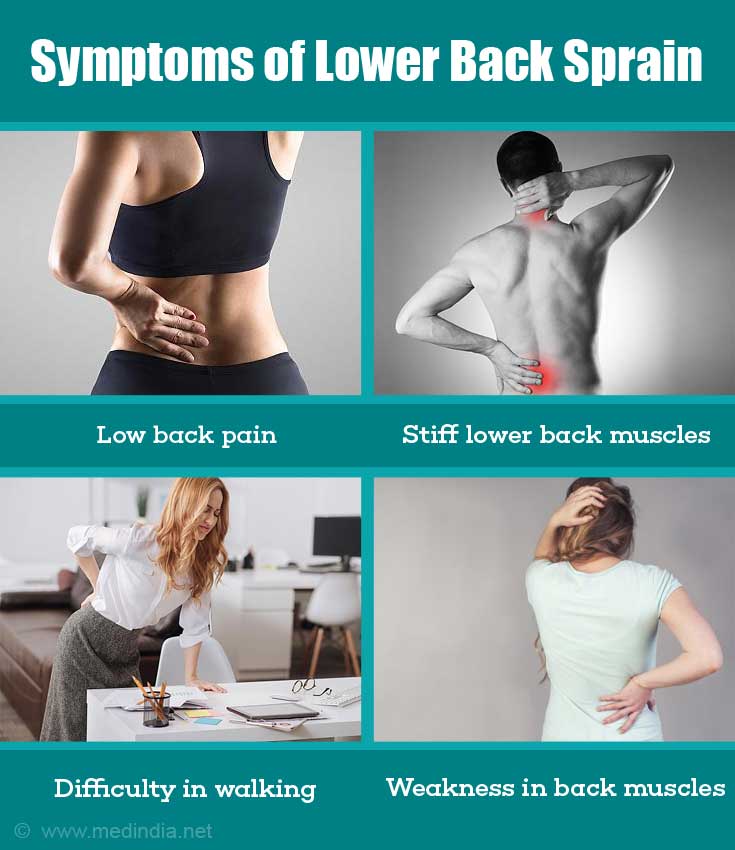
Upper Back Muscle Strain
- Pain in the mid back, which may restrict neck movements
- Pain in the upper back region that is aggravated on deep breathing, coughing, rotation of the thoracic spine, or prolonged standing
- Muscle spasms in the upper back and neck
- Tightness and stiffness of muscles in upper back region
- Decreased range of motion in the mid back, neck, or shoulder(4✔ ✔Trusted Source
Low Back Strain and Sprain
Go to source)
Diagnosis of Low Back Strain / Sprain
Medical History and Physical Examination
Mild sprain or strain in the lower back is usually diagnosed on the basis of medical history and physical examination:
- Your healthcare provider may review your medical history and ask questions such as details of your accidents, or lifestyle habits that may indicate the cause of sprain or strain
- The healthcare provider may also conduct a physical examination to identify stiffness or swelling
Imaging Studies
If the pain persists for more than two weeks and causes weakness or loss of function, the following tests are recommended:
X-ray
X-rays of the spine may be taken to rule out the possibility of a fractured (broken) bone, tumor or infection as a cause of pain
MRI
MRI scan uses a magnetic field and radiofrequency waves to generate a detailed view of the spine. MRI scan can identify if there is an injury to spinal cord or the ligaments that may be causing the pain.
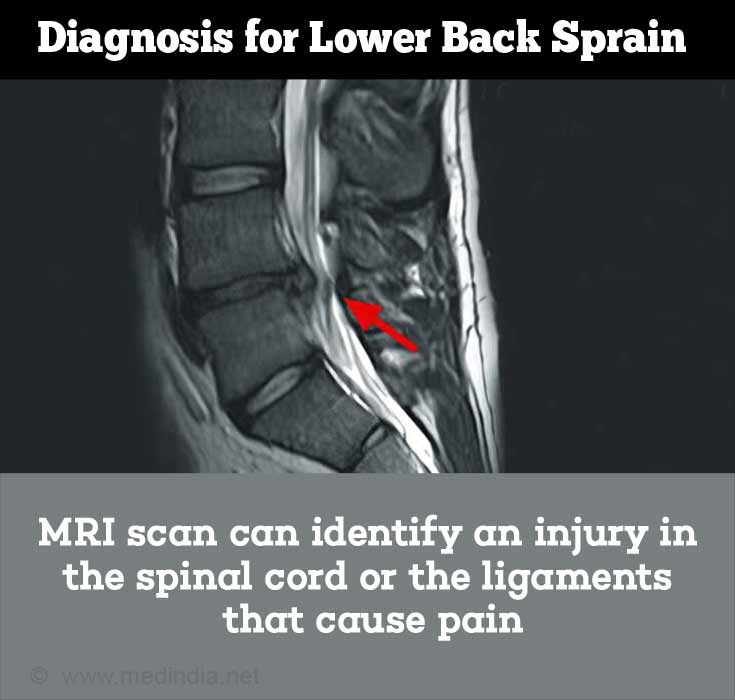
Diagnosis of Upper Back Sprain
Medical History and Physical Examination
Thoracic sprain and strain injuries are typically diagnosed on the basis of the history and physical examination. A careful spinal and shoulder examination is important to identify restrictive movements, presence of any structural deformity, tenderness, and skin changes (indication of infection or tumor).
Neurologic Testing
The neurologic testing includes motor, sensory, and reflexes examination. The doctor may ask you to do several movements such as lifting your arm overhead, extend backwards, or rotate your hand through 360 degree.
Rib motion is generally examined through excursion of the chest wall. Weakness in the lower extremity or neurologic deficit on physical examination warrants further investigation.
Imaging studies
MRI
MRI scan can identify any thoracic cancer and may also be recommended if you have localized thoracic pain with sensory-motor deficits. MRI scan also be used to rule out a possibility of thoracic disc herniation.
Computed Tomographic (CT) Scan
CT scan can identify bone abnormalities that may be causing a pain in upper thoracic region.(5✔ ✔Trusted Source
Diagnosis and Treatment of Acute Low Back Pain.
Go to source)
Treatment for Sprained / Strained Back
The main goal of the treatment for sprain or muscle strain in back is to reduce the pain and improve mobility if it is restricted. The treatment options for sprained back include bed rest, hot-cold treatment, pain-relieving medications, exercise, and surgery in most severe cases.
Bed Rest
The first step in the treatment of sprained or strained back is to reduce the spasm of muscles through rest. Bed rest is usually recommended soon after injury. This allows reducing the symptoms of spasmin the back. However, prolonged bed rest (more than 48 hours) in the early phase of pain may cause weakness in the muscles and lead to higher long-term disability level. Therefore, patients are advised to return to normal activities after 48 hours of rest.
Hot and Cold Treatment
Cold treatment involves application of ice packs and compression (pressure). It is recommended for the first 48 to 72 hours after the injury and done for 15 to 30 minutes until the anesthesia or numbness is felt on the area of application. The cold treatment reduces the edema and pain.
On the other hand, heat treatment should be started 48 to 72 hours after an injury. The heat treatment consists of hot compresses and warm baths. Heat treatment helps to relax muscles, and soothes throbbing pain and stiffness.
Medications
Medications that are mainly indicated in the treatment of a sprained or strained back include pain relieving drugs and muscle relaxants.
Pain-relieving Medications
Paracetamol
Paracetamol is an important non-opioid analgesic drug. It causes reduction of pain and fever but lacks a specific anti-inflammatory effect. Paracetamol is usually recommended for painful muscle strain or sprain in the back.
Anti-inflammatory Medications
Aspirin and other related compounds form a class of drugs known as nonsteroidal anti-inflammatory drugs (NSAIDs). These drugs reduce pain and signs of inflammation such as fever, swelling and redness. Some of the NSAIDs are available without prescription.
NSAIDs are indicated in a wide variety of musculoskeletal pain syndromes including lower back pain, back muscle strain, muscle injuries, ligament sprains, neck pain etc.
Although paracetamol and NSAIDS are effective in relieving pain arising from muscle strain in the back, their use is limited due to associated gastrointestinal side effects such as acidity, gastric bleeding and ulcers.

Muscle Relaxants
Drugs such as metaxalone, methocarbamol and orphenadrine are prescribed to relieve back pain caused due to back muscle strain. Most pain reduction from these medications occurs in the first 7 to 14 days, but the benefit may continue for up to four weeks. The side effects of these drugs include sedation, seizures and cardiac effects.(6✔ ✔Trusted Source
Low Back Pain Fact Sheet
Go to source)
Physical Therapy/Exercise
It is important to get back to activities as soon as possible even though you have some pain due to sprained back. Prolonged restriction of movements can make the back muscles weak and result in long term disability. You may work together with your healthcare provider to understand the right kind of exercises for your condition. A comprehensive exercise regimen that includes a combination of stretching, strengthening, and aerobic conditioning of the back and body are helpful are in recovering from back strain.(7✔ ✔Trusted Source
Taking Care of Your Back at Home
Go to source)
Surgery
Surgery may be indicated in severe cases when there is a rupture of ligament or muscle fiber.
How Long Does a Strained Back Take to Heal?
If appropriate treatment is given, a sprained back usually can resolve within six to eight weeks. However, the recovery time is greatly determined by the severity of the injury or the underlying cause of back muscle strain.
Prevention of Back Sprain / Strain
To avoid back sprain or strain, you need to follow some lifestyle tips as given below:
- While lifting a heavy object stand close to the load and bend at your knees keeping your back straight
- While moving after lifting the weight, shift your feet to turn and do not twist your back
- Avoid any sudden twists and jerks when you exercise or even during routine activities
- Avoid bed rest beyond 48 hours as it can lead to weakening of important muscle groups that support and stabilize your back
- Do some physical exercises such as crunches or abdominal-muscle strengthening exercises to provide more spine stability
- You may also consider exercises such as swimming, cycling or brisk walking that do not put extra stress on your back
- Avoid sleeping on your stomach as in this position your back is arched, which can aggravate your neck or back pain
- While driving keep the seat close to the driving wheel to maintain the natural curves of your body
- If you have to sit for a long time at one place, make sure you get up and stand at short intervals
- Always maintain correct posture while sitting or standing
- Keep your body weight in normal range. Extra weight can put pressure on your spine and back muscles.(8Lumbar Back Sprains: Treatment and Prevention
Go to source)



